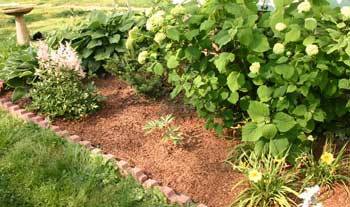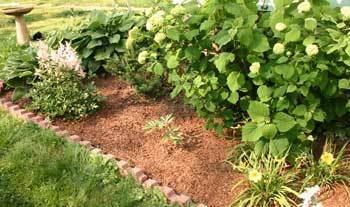
Mulch can be a gardener's best friend. When correctly applied, it can help you spend less time weeding, less time watering and less time fighting pests. It also improves the appearance of your garden, and depending on the color and texture, it can actually be a significant element in your overall garden design. Here's what to consider when choosing organic mulch for your garden.
Organic mulches are made from living material (straw, bark, grass, leaves). In general, they offer greater benefits to your garden than their non-organic counterparts because as they decompose, they add nutrients to the soil and encourage earthworms-which aerate your soil and add additional nutrients.
There is no perfect organic mulch. When choosing mulch for your garden, consider the color, the cost, the plants you're growing and the condition of your soil.

Bark (Shredded) |
| Appearance: Shredded bark is generally made from cypress, cedar, redwood, or eucalyptus trees and has an attractive appearance. The color usually fades quickly. |
| Insulation: Good |
| Cost: High |
| Water Penetration: Fair, but may actually repel water if improperly applied. |
| Moisture Retention: Good |
| Weed Control: Fair |
| Depth of Application: 2-3 inches |
| Decomposition Rate: Very slowly. Microorganisms use nitrogen as bark decomposes. Because nitrogen is taken out of the soil during decomposition, bark should not be dug into the soil unless a high-nitrogen fertilizer is used along with the application. |
| Pros: Shredded bark can repel some insects; it also holds well on sloping grades and lasts several seasons before needing replacement. |
| Cons: Earthworms avoid redwood. The color fades quickly and applications may need to be balanced with the addition of nitrogen. |
Cocoa Bean Hulls |
| Appearance: Cocoa Bean hulls are by-products of the chocolate industry. They have a fine texture and a lovely dark brown appearance. |
| Insulation: Good |
| Cost: Moderate to high |
| Water Penetration: Good |
| Moisture Retention: Good |
| Weed Control: Fair |
| Depth of Application: 2-3 inches |
| Decomposition Rate: Rapid. Cocoa shells disappear after one season and need to be reapplied yearly. |
| Pros: Wonderful chocolate smell (although it fades) and nice appearance. Cocoa Bean hulls hold their color all season and will not weather like wood mulches. |
| Cons: Not suited for grades with a slope or in areas that experience heavy run-off. When hulls dry, they may form a crust. If applied too thickly, they get moldy. Not safe for ingestion by cats and dogs. |
Grass Clippings |
| Appearance: Grass clippings should not be applied as mulch until they dry and turn a yellowish brown. If applied fresh (green), they can heat up enough while decomposing to harm plants. |
| Insulation: Good |
| Cost: Low |
| Water Penetration: Good if not matted |
| Moisture Retention: Good if not matted |
| Weed Control: Fair |
| Depth of Application: 1/2 inch to 1 inch maximum |
| Decomposition Rate: Rapid. Quickly adds nitrogen to the soil. |
| Pros: Grass clippings add nutrients and nitrogen to the soil quickly and are extremely inexpensive and easy to obtain. |
| Cons: Can contain herbicides and other chemicals from lawn care. Clippings also have the potential to introduce new seeds into your garden and if added while fresh, can heat up and cause damage to nearby plants. |
Leaves (Shredded) |
| Appearance: Once dry, shredded leaves are brown in color and fade over the course of time. They tend to be poor in appearance if not dried. |
| Insulation: Good |
| Cost: Like grass clippings, shredded leaves are readily available and cost effective. |
| Water Penetration: Fair. Can have problems with matting. |
| Moisture Retention: Good |
| Weed Control: Fair. Can have problems with matting. |
| Depth of Application: 4-6 inches |
| Decomposition Rate: Shredded leaves decompose fairly rapidly and add nitrogen into the soil. Some leaves, like oak, can slightly increase acidity levels in the soil. |
| Pros: Shredded leaves add organic matter and nutrients to the soil. They are inexpensive and can be added to other types of mulch. |
| Cons: Leaves break down quickly and have a tendency to form a mat over the soil. |
Newspaper |
| Appearance: Poor as a design element. |
| Insulation: Good |
| Cost: Newspaper is readily usually readily available and inexpensive. |
| Water Penetration: Fair |
| Moisture Retention: Good |
| Weed Control: Excellent |
| Depth of Application: 1 to 2 layers |
| Decomposition Rate: Rapid. Newspaper will generally last one season. |
| Pros: Newspaper provides excellent weed control, is inexpensive and readily available. It works very well when used between rows and on paths. |
| Cons: Newspaper works excellent as weed control, and will also inhibit new growth. If used as fall or winter mulch it needs to be removed in the spring to allow emerging growth. Needs to be held in place by heavier objects. |
Peat Moss |
| Appearance: Has a natural, organic appearance. |
| Insulation: Good |
| Cost: Moderate to High |
| Water Penetration: Poor. Peat moss absorbs |
| Moisture Retention:Poor. Draws moisture away from soil. |
| Weed Control: Good |
| Depth of Application: 1 inch |
| Decomposition Rate: Very slow |
| Pros:Peat moss is valuable as a soil conditioner |
| Cons: Peat moss adds little or no nutrients to the soil and should be used only as a soil conditioner. It also absorbs water and can draw water out of the soil rather than helping soil retain water. |
Straw |
| Appearance: Good if chopped. |
| Insulation: Good |
| Cost: Low to moderate depending on availability |
| Water Penetration: Good |
| Moisture Retention: Good |
| Weed Control: Good, but may contain weed seeds |
| Depth of Application: 4-8 inches |
| Decomposition Rate: Fairly slow. Straw is the perfect mulch for digging in at the end of the season. |
| Pros: Straw holds well and resists matting. It's commonly used in vegetable gardens and is one of the best mulches for strawberry plants. |
| Cons: Straw needs to be replaced every season and can contain weed seeds. |
Wood Chips/Nuggets |
| Appearance: Attractive colors and textures. May retain pine or cedar scent. |
| Insulation: Good |
| Cost: Moderate to High |
| Water Penetration: Good |
| Moisture Retention: Good |
| Weed Control: Fair |
| Depth of Application: 2-4 inches |
| Decomposition Rate: Fairly slow. Large chips can take several seasons to decompose and don't deplete the soil of nitrogen as much as shredded bark. |
| Pros: Wood chips/nuggets are attractive, readily available and retain their color fairly well. |
| Cons: Wood chips/nuggets are not suited for sloping grades or for areas that experience heavy water run-off. Coarse nuggets are less effective at retaining moisture and weed control than finer nuggets. |
To figure out how much mulch you need, measure the size in square feet of the area you want to cover in your garden (multiply garden's length x width). Decide how deep you need it to be in inches (usually a minimum of 2 inches). Now multiply the square feet of the area you're covering by the depth you need in inches and divide that number by 324. The resulting number will be the amount of mulch you need in cubic yards, the measurement mulch is commonly sold in.

About The Author: Ellen Brown is an environmental writer and photographer and the owner of Sustainable Media, an environmental media company that specializes in helping businesses and organizations promote eco-friendly products and services.
Add your voice! Click below to comment. ThriftyFun is powered by your wisdom!